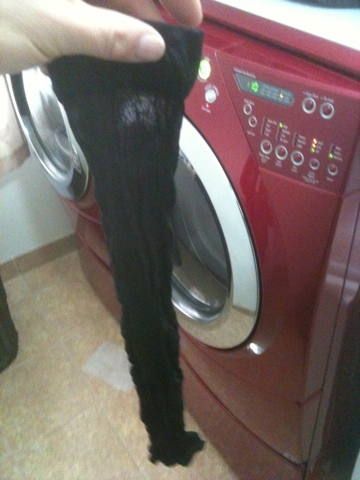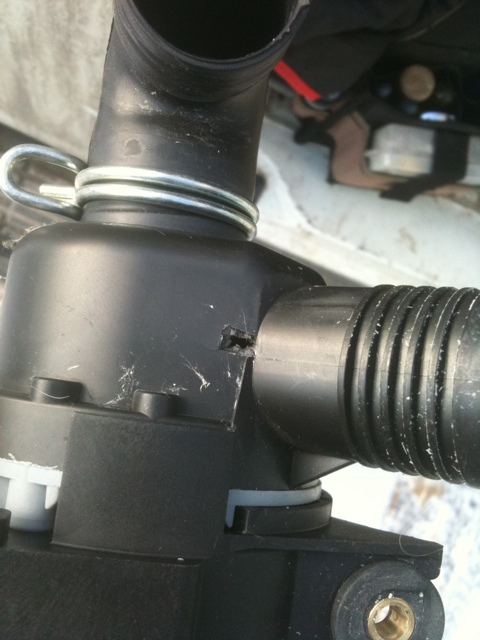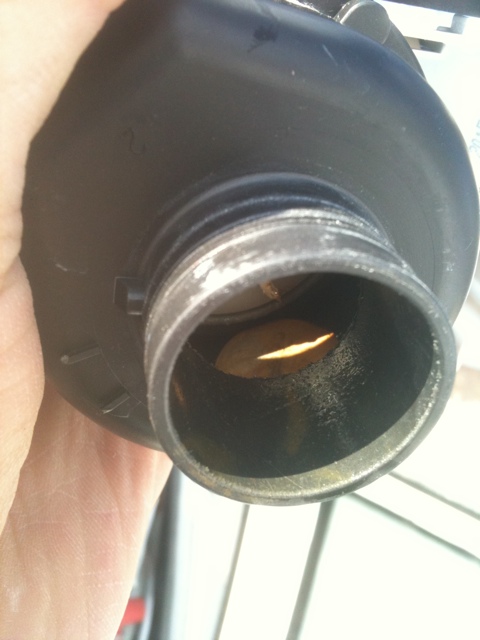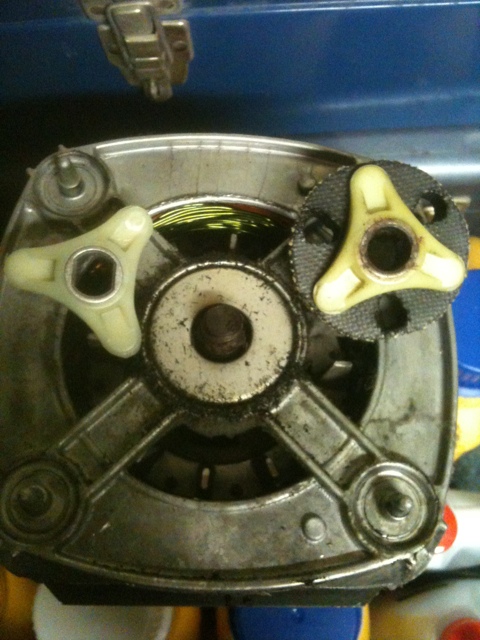Repairs
Tips and Advice
-
The $90 Stocking
My very next call! A beautiful Whirlpool Duet washer not draining. Pulled this lovely black ladies stocking out of the drain pump. $90 later and the washer is back in working order and everything (including stockings) are back where they should be. A big thank you to the inventor of ladies stockings!
Do you see a trend forming here?
-
The $90 Hairpin
I love hairpins almost as much as I love loose change. This one was stuck in the drain pump of a front loading Inglis washer. $90 later and everything is back in order and where everything should be. Thank you hairpin inventor.
-
Empty The Pockets When Loading Your Washer
Here is another example of why you should always empty the pants pockets when loading your washing machine. This pump is from a rather expensive Whirlpool Cabrio clothes washer. See the little hole where the hose stem joins the body of the pump on the 1st photo? That was caused by the penny that was in the pump (see it sitting there in the 2nd photo.) The drain pump kicked that penny hard enough to punch a hole in the body of the pump. A $250 repair and a flooded basement later and the customer can do laundry again.
BTW – this unit was on the main floor of the house, so when it flooded it also ruined a section of the ceiling in the basement.
Empty the pockets folks – or keep my number handy, you’re gonna need me.
-
Whirlpool Washer not Spinning
First time I’ve see this. This is a Whirlpool design Maytag washer. Model MTW5920TW0. The customer complaint was that is was not spinning and was making a funny noise. I came here expecting to find a broken motor coupler – wrong! This is a testament to how tough the new style motor couplers are. The shaft of the motor was worn completely round inside the coupler. In the picture, you can see a good coupler with flat sides in the left. The motor shaft and the old coupler on the right are completely round.
New motor and coupler and she’s as good as new.
-
Whirlpool OTR Microwave Turns On or Off by Itself
This control board came from a microwave that would occasionally turn itself on by itself. I don’t think the mag was actually firing, but the fan was coming on. It would also occasionally make a high pitched electronic whining sound. Traced it to the control board. This is the old control board – check out the corrosion on the back. Never heard back, so it definitely fixed the problem.

-
Kitchen Aid Dishwasher Not Draining
 Here’s a hint for all you tech’s and DYI’ers out there.
Here’s a hint for all you tech’s and DYI’ers out there.If you have a Whirlpool or Kitchen Aid dishwasher that is either not draining or draining slow … and you’ve checked all the regular culprits for this problem (blocked drain hose at sink stack, crushed or collapsed hose, plugged sump, etc.), then you need to check the backflow check-valve in the hose itself.
The valve is a little rubber flapper and is located inside the hose just before the 90 deg elbow where the drain hose fits onto the bottom of the sump/pump.
If you use a flashlight and backlight it, you should see it flap open when the drain pump starts. It will look like a little black circle sitting on the side of the drain hose.
If junk gets stuck up behind it, the flap can be prevented form opening all the way. Also, if the flap gets lodged into the opening instead of resting on the face, it will not open up all the way.
In the video, you can clearly see it moving slightly as the water rushes by it – that is what you should be seeing.
-
Noisy Duet Washer
This is a noisy Duet style Whirlpool front loading washer. It begins to make a knocking sound as the unit begins to wind up on the spin cycle. It is not the normal rumbling sound of a bad bearing. To my ear it sounds like a loose pulley wheel – but I’ve tightened the pulley nut as tight as I can, and the sound is still the same. When I look at the edge of the pulley, I notice that it is not completely round – it was a wobble to it. So I will try replacing the pulley to see if that fixes the sound. If not, I guess it will be the rear drum bearing.
Update: this one did end up being a rear drum bearing. Usually the rear bearing makes a rumbling or grinding noise – this noise was different than the norm. But it is fixed.
-
LF Code on a Whirlpool Duet Style Front Loading Washer
The unit will not fill and is flashing up the code LF. LF stands for Long Fill and can be triggered by anything from a water supply problem to pressure switch problems. In this case there was no water coming to the unit … so the fill was extra long! Lol.
EDIT: Other things to check for with a LF code:
1. Did someone tell you that you could use just cold water on your washer? I’ve noticed a lot of people trying to use their washers with only a cold water hookup. The various new ‘cold water’ detergents have not helped either. Your Duet washer will not work properly with only the cold water hooked up. It still measures the temperature of the water entering the machine, and if it is too cold it will still add some hot to bring the water temp up a bit. I think it tries to make it around 68 deg. Here in Canada, our tap water can be down as low as the low 40’s F – so a fair amount of hot water is required to bring the temp up. The next question I hear you asking is … why? I wan’t to use just cold water. Well, actually, no you do not. Do this as an experiment. Take the cold water from your tap and measure the temp. If it is below 50 degrees, add a handful of detergent and see what what happens. It will not dissolve … or if it does it will be sort of thick. Soap’s need a certain degree of warmth to activate and tap cold is often too cold to do that. Your clothes will not be washed properly in this situation.
2. Anti-flood hoses. These hoses were designed to shut off a flow of water if they burst. So … a couple of things about these. They only come in braided stainless steel. I’ve never seen one of those hoses burst. They are wrapped in a sheath of stainless steel metal … they can’t burst. So why the anti-flood valves built in? Answer: so they can charge you more. Next: those hoses are famous for triggering off the anti-flood valve on just a regular washer fill. Often it will be just one hose that it happens on, but that means that when it is calling for water from that hose and not getting it, the LF code will be triggered. This most often shows up on the rinse cycle.
3. If you are getting LF and water is entering the machine … and creeping up the glass on the door, then you have a water pressure switch or pressure hose problem. Check out this post for one of the more common problems I see with the pressure hoses. In this case, water is actually coming in, the machine is just not able to sense it coming in.
4. Kinked fill hose?
5. Taps turned off?
6. Are your feet wet? Is the water coming in but draining out via some major leak on the bottom? lol.
EDIT 2: See my post F20 On A Duet Washer for another very common cause of LF Codes.
If any of these ideas helped you or if you found it to be something else, please add a comment here for me. I learn as much from others as I do from my own observations!
-
Leaking Water Dispenser
This is a brand new Kitchen Aid refrigerator. The water dispenser leaks anywhere from 2 drips to a couple of dozen drips. This problem is being caused by air entering into the water system somewhere. You can tell that it is air in the system by the little ‘spurt’ that you can see about 1/2 a second into the video. This air bubble happens every time the water dispenser paddle is pushed. I traced the air bubbles back as far as the tank in the fresh food section – I can see bubbles entering the tank when I call for water. This eliminates everything after the water tank as the source of the air. The parts left are the water filter, filter housing, water valve and interconnecting tubing. I’m leaning toward the filter housing being the problem, so I will try that first.
-
Overflowing Icemaker
This bottom mount Whirlpool fridge was making ice non-stop. After removing all the ice, I found the ice-maker shutoff arm was no longer inserted into the ice-maker. I reinstalled it and now this unit should shut off when the bucket is full. This problem was probably caused by putting a box on top of the ice bucket and then shutting the door.








